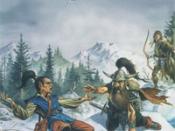As a stunningly beautiful work of art, "Wanderlust: The history of walking", by Rebecca Solnit, realistically and ravishingly exposes and performs a harmonious melody and astonishing combination of the language in the text and the act of walking. In "Wanderlust" Rebecca Solnit weaves together all the aspects of human experiences to chronicle the act of walking successfully. Moreover, not only does Solnit's language artistically and literately delineate a beautiful picture about walking, but, unfadingly, that it inextricably entwines with the act of walking also engraves a perfect harmonization of human bipedal motion.
"Walking is to make the body and its actions express the desires and beliefs of the soul" Solnit stated. Spiritually and philosophically, walking itself is a motion in which desires and beliefs are naturally created in the walker's soul and heart; particularly, vigorous desires to overcome and cross all the excursions and solid beliefs to reach the final goals and destinations are strongly expressed.
In Wanderlust, not only does the language that Rebecca Solnit uses, beautifully and profoundly, express her desires, inmost emotions and thoughts about the meaning of walking, but it also manifests the desires and beliefs of the souls of the readers/ people/ walkers. Solnit's language creates strong ambitions and beliefs for the readers to keep crossing each page carefully in order reach the final meaning of Wanderlust. Walking is the act of desires of endless distances. Language is also a manifestation of desires. "If writing is language and language is desire and longing and suffering" Mars stated. The distance of words from the author's mind and the paper is also reflection of desires.
Walking is an art in which the walker is truly an artist. In the act of walking, the walker, as a point on the contours of a colorful...


